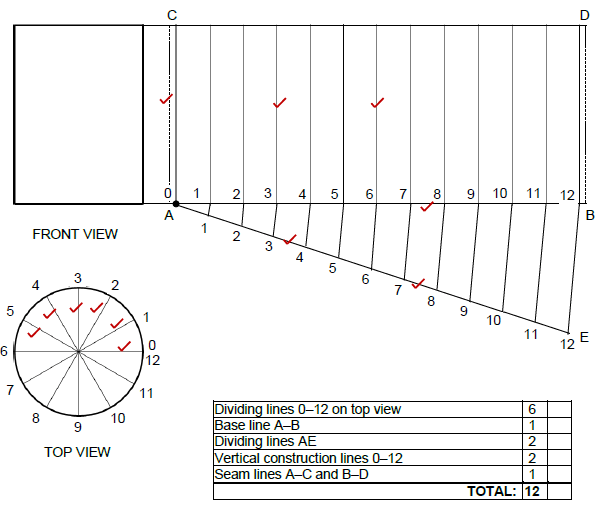Civil Technology: Civil Services Memorandum - Grade 12 September 2021 Preparatory Exams
Share via Whatsapp Join our WhatsApp Group Join our Telegram GroupINSTRUCTIONS FOR THE MARKERS
- Markers should:
- Familiarise themselves with the question and answer before evaluating the responses of candidates.
- Always interpret the responses of the candidates within the context of the question.
- Consider any relevant and acceptable answer during pre-marking but should strictly adhere to the answers after finalisation of the marking guideline.
- There are two approaches to answering questions, these are (1) to describe and (2) to explain.
- If a candidate is required to explain e.g., a process in 4 steps, only the first 4 responses should be considered.
- If, however a candidate is required to e.g., explain or describe how to transfer heights from one point to another using a transparent pipe level we need to consider that candidates may write a long description not necessarily well organised as an intellectual response may do. In this case the marker needs to evaluate the complete statement to judge if the candidate explained the required outcome satisfactorily and allocate marks on merit. The marker should apply his/her professional judgement with these types of questions.
- Mark what the candidate wrote and do not award marks for answers that the marker thinks the candidate meant with what was written.
- Indicate the tick or cross right at the position where the mark needs to be awarded or where the candidate made the error.
- Accept the letter corresponding with the correct answer as well as the answer written in full in multiple-choice questions.
- Accept incorrect spelling in one-word answers unless the spelling changes the meaning of the answer.
- For calculations:
- A mark is only awarded if the correct unit is written next to the answer.
- If TWO marks are awarded ONE mark is awarded for the answer and ONE mark for the correct unit.
- Where the candidate made a principle error e.g. added instead of multiplying, no marks will be awarded for the steps. If the answer is correct according to what the candidate did, the mark for the answer can be awarded for the application of skills.
- Where an incorrect answer could be carried over to the next step, the first answer will be deemed incorrect. However, should the incorrect answer be carried over correctly, the marker has to recalculate the values, using the incorrect answer from the first calculation. If correctly used, the candidate should receive the full marks for subsequent calculations.
- Markers should consider when and where a candidate has rounded off in a calculation, as well as the subsequent effect it has on the final answer obtained. The calculation should therefore be awarded marks on merit.
- Alternative methods of calculations must be considered, provided that the correct answer is obtained.
- When marking drawings:
- The member for which the mark should be awarded should be drawn correctly in the correct position to receive a mark.
- A member incorrectly drawn but wrongfully repeated in another position will be awarded the mark for the repeated incorrect member provided that the marking guideline provide for TWO or more marks for that member (positive marking).
- Marks can only be awarded for a label if the label is correctly indicating the correct member.
- Scale drawings should always be marked using an appropriate mask.
When a candidate drew the wrong drawing e.g.: - A horizontal section instead of a vertical section, no marks will be allocated to the drawing as the candidate did not respond to the expected outcome.
- An orthographic view instead of sectional view, no marks will be allocated to the drawing as the candidate did not respond to the expected outcome.
- An orthographic view instead of an isometric view, no marks will be allocated to the drawing as the candidate did not respond to the expected outcome.
- If the incorrect drawing was drawn, the candidate can be awarded for only what was asked but mark/s for the correctness of the drawing will not be awarded e.g., if a King Post roof truss was asked in the question, and candidate drew SA-Howe Truss.
MEMORANDUM
QUESTION 1: SAFETY AND MATERIALS (GENERIC)
1.1 Answer the following question regarding scaffolding.
1.1.1
- – Guardrail (1)
- – Planks / Working platform (1)
- – Kickboard / Toe-board (1)
- – Brace (1) (4)
1.1.2 228 mm (1) x 38 mm (1) (2)
1.1.3 Provides stability to the scaffolding. (1)
1.1.4 Minimum = 900 mm (1) and maximum = 1 000 mm (1) (2)
1.2
1.2.1 Placing of building rubble:
- May not obstruct access or exits
- Safe place
- Regularly removed. (Any 1 x 1) (1)
1.2.2 When materials are transported to higher surfaces:
- Workers must maintain a safe distance
- Overhead protection (Any 1 x 1) (1)
1.3 Any THREE:
- Non-skid devices on the bottom
- Hooks at the upper ends
- Lashed, secure or fastened
- Held by someone (Any 3 x 1) (3)
1.4 Rungs (1)
1.5 The coating of a metal by electrolysis (1) with a thin layer of another metal. (1) (2)
1.6 To improve the metal’s corrosion resistance. (1)
1.7 Any TWO:
- Adds strength to the metal
- Galvanised metals are thicker
- Galvanised nails and screws prevents staining (Any 2 x 1) (2)
[20]
QUESTION 2: GRAPHICS, JOINING AND EQUIPMENT (GENERIC)
2.1 FIGURE 2.1 on ANSWER SHEET A shows a floorplan of a storeroom on scale 1 : 50. Draw the south elevation on scale 1 : 50 on ANSWER SHEET A from the given ground level, by using the following information:
- The floor level height is 200 mm above the ground level
- Wall height is 2 600 mm from the floor level to the ceiling
- Window 1 is 1 200 x 900 mm
- Door 1 is 1 100 x 2 100 mm
- Doorknob
- Roof construction pitch is 30°
- Show construction lines to determine the roof height
- Gable end at the west elevation
- Hippen end at the east elevation
Use the marks table on ANSWER SHEET A as reference. (29)
2.2
- – Nut with built-in washer like a flange (1)
- – Wing nut (1)
- – Domed top nut (1) (3)
2.3 Any TWO:
- Resist pull-out failure
- Excellent carrying capacity
- Tolerance to a variance in the hole size (Any 2 x 1) (2)
2.4 Must be set-up that the telescope (1) is placed on a comfortable sightline (1) to prevent a person from bending or stretching over the telescope and tripod (1).
(3)
2.5 Any THREE:
- Wiring
- Wood
- Metal studs
- Copper pipes
- Plumbing work (Any 3 x 1) (3)
[40]
TOTAL SECTION A: 60
QUESTION 3: SAFETY, MATERIAL AND CONSTRUCTION (SPECIFIC)
3.1 FIGURE 3.1 shows workers who must work in a manhole. Answer the following questions regarding the safety measures which must be applied.
3.1.1 Similar answer:
- Prevents material or persons falling in.
- Identifies a danger zone. (Any 1 x 1) (1)
3.1.2 Similar answer:
- Pipe for extractor fan or blower.
- Provides manhole workers with fresh air. (Any 1 x 1) (1)
3.1.3 When (1) dangerous fumes / gases are (2) present in the manhole / confined spaces. (2)
3.1.4 Respirator (1)
3.2 Similar answer:
- Safety net
- Catch platform
- Rails / Barriers
- Hard hat (Any 1 x 1) (1)
3.3 Any TWO:
- Electrical tools
- Battery tools
- Fuel tools (Any 2 x 1) (2)
3.4
3.4.1 True (1)
3.4.2 False (1)
3.4.3 True (1)
3.4.4 True (1)
3.5 Scale or corrosion products (1) are removed (2) by subjecting it as an electrode (3) to an electrical current (4) in an electrolytic bath. (4)
3.6 FIGURE 3.6 on ANSWER SHEET B shows layer 1 of a T-junction in a one-brick wall in stretcher bond. Draw the alternate layer of the T-junction on scale 1 : 10 on ANSWER SHEET B. (7)
3.7 English bond (1)
3.8 Give access to drain system / Cleaning of drain system (1)
3.9 Make a neat section sketch in good ratio to illustrate a manhole construction with benching. Show the following parts and indicate it with labels:
- Concrete base
- Brick walls
- Pipe channel
- Benching
- Cover frame and cover
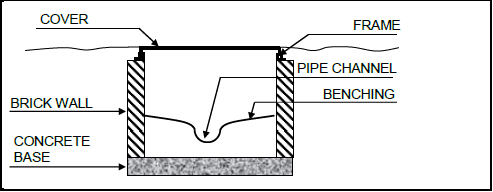
(5) [30]
QUESTION 4: COLD-WATER SUPPLY, HOT-WATER SUPPLY AND EQUIPMENT (SPECIFIC)
4.1 Any THREE properties of water
- Colourless
- Free from suspended matter
- Free from harmful bacteria
- Pleasant to taste
- Moderately hard (Any 3 x 1) (3)
4.2 Prevents water from leaking from the spindle. (1)
4.3 It reduces splashing / water noise. (1)
4.4 Answer the following questions regarding the valve in FIGURE 4.4.
4.4.1 Non-return valve (1)
4.4.2 B (1)
4.4.3 Open (1)
4.4.4 Where water flows only in one direction. (1)
4.5 Answer the following questions regarding FIGURE 4.4.
4.5.1 S-trap (1)
4.5.2 (1) Keeps water back to (2) prevent odours passing to the inside. (2)
4.5.3 Inspection eye (1)
4.5.4 Cleaning of trap (1)
4.6 Wastewater – water contaminated by human waste / pollutants. Soil water – water from the sink / basin / bath / shower. (2)
4.7 Describe TWO advantages of electronic taps.
- It only allows water to flow through when the sensor is triggered / saves water.
- You do not need to touch the tap. (2 x 1) (2)
4.8 (1) Polluted water harms (2) mechanisms of valves and tap washers. (2)
4.9 4.9.1 Expansion-control vessel (1)
4.9.2 Mixer (1)
4.9.3 Non-return valve (1)
4.9.4 Float valve (1)
4.9.5 Pressure-control valve (1)
4.10 Make neat sketches of the following symbols for hot water systems.
4.10.1 Pressure-reducing valve ![]() (2)
(2)
4.10.2 Vacuum-relieve valve  (2)
(2)
4.11 (1) It occurs when a pipe bursts / faulty plumbing (2) traps air in a high point. (3) The air blocks the (4) flow of water. (4)
4.12
4.12.1 True (1)
4.12.2 True (1)
4.12.3 True (1)
4.13 Loose clothing can get caught in the moving parts. (1)
4.14 Name TWO tools which are used for cleaning blockages in drains.
- Drain-cleaning rods
- Drain-cleaning or jetting machine (2 x 1) (2)
4.15 Water pressure testing pump (1)
[40]
QUESTION 5: DRAINAGE AND QUANTITIES (SPECIFIC)
5.1 Describe the following requirements for an efficient drainage system.
5.1.1 Smooth finishing (1)
5.1.2 100 mm (1)
5.1.3
- Where 2 or more pipes meet
- At the main pipeline junction
- Every 25 metres (3)
5.2 (1) Where ground movement occur and (2) leakages must be prevented. (2)
5.3 Name TWO properties of earthenware drainpipes.
- Brittle
- Durable (2 x 1) (2)
5.4 Make a neat section sketch of a coupling socket joint for drainpipes. (3)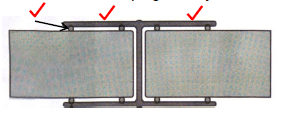
5.5 Name TWO positions in a drainage system where gullies must be installed.
- Wastewater connection at drain from the kitchen.
- Wastewater connection at drain from the bathroom. (2 x 1) (2)
5.6 Choose the correct description regarding a septic tank.
5.6.1
- Sewerage
- Water closet (2)
5.6.2 Sink to the bottom of the chamber (1)
5.6.3
- Bacteria
- Liquid (2)
5.6.4 Sludge (1)
5.7 Give the colour coding for the following drainage fittings:
5.7.1 Brown (1)
5.7.2 Blue (1)
5.7.3 Black (1)
5.8 Identify the following abbreviations for drainage fittings:
5.8.1 IR – Inspection room (1)
5.8.2 ST – Septic tank (1)
5.8.3 CE – Cleaning eye (1)
5.9 Test if drains are airtight / watertight. (1)
5.10 The side of a cubic water supply tank is 1 800 mm. Determine the following of the tank.
(Show all calculations and formulas.)
5.10.1
- Volume = S3
= 1,8 x 1,8 x 1,8
= 5,83 m3 (3)
5.10.2
- Volume water = 5,83 m3 x 1 000 ℓ/ m3
= 5 830 ℓ (2)
5.11 FIGURE 5.11 shows the pictorial view of a part of the layout for a drainage system. Answer the following questions regarding the system.
5.11.1
- – Stop end
- – 90° Single T-junction
- – Waste pipe
- – Waste bent (4)
5.11.2 Ø 110 mm (1)
5.11.3 Ø 50 mm (1)
5.11.4 PVC (1)
5.11.5 620 mm (10 mm tolerance) (1)
[40]
QUESTION 6: GRAPHIC COMMUNICATION, ROOF WORK, STORMWATER AND JOINING (SPECIFIC)
6.1 FIGURE 6.1 on ANSWER SHEET C shows the top and front view of a cylindrical pipe. Draw the development of the cylindrical pipe on ANSWER SHEET C. Show all construction lines. (12)
6.2 Indicate if the following statements are TRUE or FALSE. Write only ‘true’ or ‘false’ next to the question number in the ANSWER BOOK.
6.2.1 True (1)
6.2.2 True (1)
6.2.3 False (1)
6.2.4 True (1)
6.3 Join gutters (1)
6.4 Bottom of a downpipe (1)
6.5 Discuss the following regulations which are applicable to stormwater disposal.
6.5.1 (1) It must be drained away from the building (2) to prevent damage to property. (2)
6.5.2 (1) At least 5 m away from any building (2) to prevent any accumulation of dampness. (2)
6.6 Name THREE negative consequences of storm water constructions which do not comply to the requirements.
Any THREE:
- Discomfort of occupants
- Loss of life
- Damage to property
- Pollution of the environment
- Negative environmental impact (Any 3 x 1) (3)
6.7 (1) Assists in cleaning the material / prevents oxidation (2) and promotes the flow of solder. (2)
6.8 Resin (1)
6.9
- – Pop rivet
- – Lap joint with cover strip (2)
[30]
TOTAL: 200
ANSWER SHEET A
2.1 FIGURE 2.1 shows the floor plan of a storeroom on scale 1 : 50.
Draw the south elevation on scale 1 : 50 on ANSWER SHEET A from the given ground level. (29)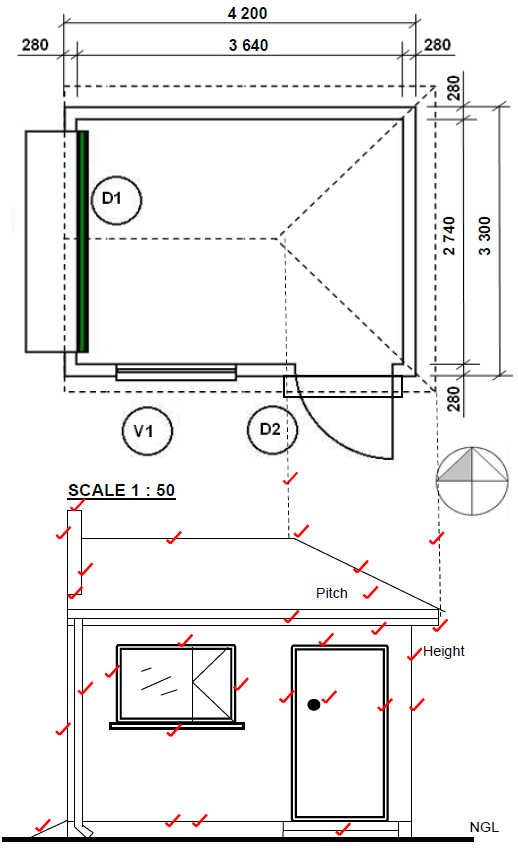
Floor level | 2 | |
Wall | 3 | |
Window | 3 | |
Windowsill | 1 | |
Door | 4 | |
Stairs | 1 | |
Ramp | 1 | |
Fascia board | 2 | |
Gutter | 1 | |
Down pipe | 1 | |
Gable ent | 4 | |
Hipped ent | 3 | |
Roof height | 3 | |
TOTAL: | 29 |
ANSWER SHEET B
3.6 FIGURE 3.6 on ANSWER SHEET B shows layer 1 of a T-junction in a one- brick wall in stretcher bond. Draw the alternate layer of the T-junction on scale
1 : 10 on ANSWER SHEET B. (7)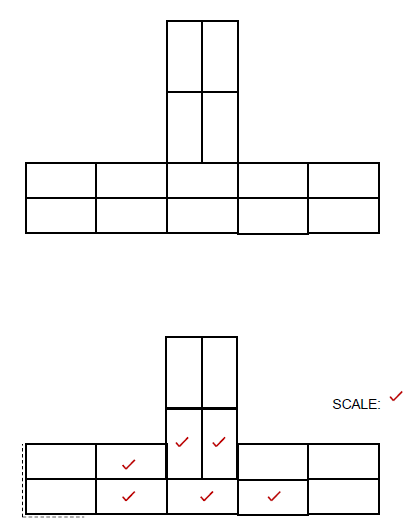
Brickwork | 6 | |
Application of scale | 1 | |
TOTAL: | 7 |
ANSWER SHEET C
6.1 FIGURE 6.1 on ANSWER SHEET C shows the top and front view of a cylindrical pipe.
Draw the development of the cylindrical pipe on ANSWER SHEET C. Show all construction lines. (12)